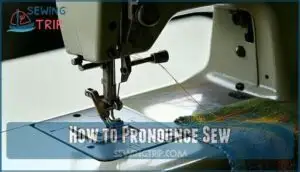This site is supported by our readers. We may earn a commission, at no cost to you, if you purchase through links.
 If you’re wondering how to pronunciation "sew," it’s simpler than it looks.
If you’re wondering how to pronunciation "sew," it’s simpler than it looks.
You say it like "so," ignoring the "w" entirely.
This might sound odd at first, but it’s the correct way in both UK and US English.
The silent "w" is a quirk of English spelling rules, much like in "sword" or "wring."
To master it, practice saying it slowly—focus on blending the "s" and "o" sounds smoothly.
Listening to native speakers or using audio tools can also help.
Understanding these subtleties makes pronunciation feel less intimidating and more natural over time.
Curious about other tricky words?
Table Of Contents
Key Takeaways
- You pronounce "sew" like "so," ignoring the "w" entirely—it’s the same in both UK and US English.
- UK accents say it as /səʊ/, while US accents say /soʊ/—both use a smooth diphthong vowel sound.
- Practice saying "sew" by blending the "s" and "o" sounds smoothly; listening to native speakers can help.
- Focus on tools like apps, audio guides, and repetition drills to sharpen your pronunciation skills.
Learn Sew Pronunciation
Master the art of saying "sew" with precise pronunciation—unlock fluency and confidence in both UK and US English accents.
When learning how to say "sew," it’s important to focus on both the sounds and their differences in British and American English.
Understanding the phonetic breakdown and practicing with audio can help you pronounce it correctly, which is crucial for complete concepts like this to be mastered.
Mastering the phonetic breakdown of "sew" unlocks clarity and fluency, transforming small details into profound communication skills.
UK and US Pronunciation
The sew pronunciation varies slightly between UK and US accents.
In the UK, it’s pronounced as /səʊ/, while in the US, it’s /soʊ/.
Both use a diphthong vowel sound, but the UK version leans softer.
Regional variations and accent influences shape how people pronounce "sew."
Mastering these differences helps you understand how to say "sew" more effectively, and mastering is crucial for clear communication.
Phonetic Breakdown
Understanding how to say "sew" precisely starts with breaking it into clear sounds.
Focus on:
- Vowel sounds: UK uses /əʊ/, while US favors /oʊ/.
- Diphthong analysis: Both accents glide smoothly between two vowels.
- Consonant clarity: Start with a sharp /s/.
- Sound blending: Practice a seamless flow.
- Regional phonetics: Differences enrich language nuances.
Audio Support Requirements
To hear "sew" correctly, you’ll need good audio accessibility and clear sound quality.
Make sure your browser compatibility is up to date, as playback issues can affect speech clarity. Adjust volume control to catch subtle pronunciation details.
A quality pronunciation guide with reliable sew audio guarantees accuracy. Listening often improves your grasp of specific sounds.
Understanding the correct pronunciation of sewing is vital for clear communication and mastering the sound of sew.
How to Pronounce Sew
Learning the pronunciation of "sew" helps you connect with English fluency and clarity. The word sounds like "so" in both UK and US English, even though it’s spelled differently.
This pronunciation choice isn’t random—it reflects word evolution and the origins tied to sewing practices. Practice saying it aloud to feel confident.
Here’s a helpful guide:
- Break it down: Start with "s" as in "say" and finish with "oh" as in "go."
- Remember its homophones like "sow" (plant seeds) for quick recall.
- Think of mnemonics like "Sewing Opens Wins" to aid memory.
- Consider its grammar: It’s a verb, often linked to creation or fixing.
- Notice examples like "She’ll sew up that tear in no time.
The correct pronunciation, as discussed in pronunciation tips for sewing, is essential for clear communication.
Sew Pronunciation Guide
You can master the pronunciation of "sew" by focusing on its clear sounds and understanding variations like UK and US accents.
This guide breaks it down so you can say it with confidence in both formal and casual conversations.
Formal Pronunciation Tips
To pronounce sew formally, focus on enunciation clarity. Say it like "soh," ensuring syllable emphasis on smooth vowel flow.
Aim for an articulate sound with a refined tone, much like a professional tailor explaining their craft. Practice articulating the sew IPA /səʊ/ (UK) or /soʊ/ (US) for precision.
Proper pronunciation creates a polished impression. Over time, pronunciation inaccuracies emerged in certain dialects.
Informal Pronunciation Variations
For a casual “sew,” your informal pronunciation leans into a relaxed tone.
The sounds blend effortlessly, keeping things natural. You could copy how native patterns sound during casual conversations.
Here are tips:
- Blend softly: Let “sew” flow, almost like “so.”
- Watch accents: Regional drawl might stretch vowels.
- Stay consistent: Use informal pronunciation appropriately.
Regional Accent Influences
Regional accents shape how "sew" sounds in American and British English.
A Southern drawl may stretch it like “sow,” while Northern variations and Midwestern influence keep it closer to “so.”
Coastal accents often add subtle flair.
British English leans in the direction of refined “səʊ.”
These dialectal differences reflect local speech habits and show how accents enrich pronunciation nuances and local speech habits, with a refined touch.
Mastering Sew Pronunciation
You can master the pronunciation of "sew" by combining practice with the right tools. Focus on listening carefully and repeating the sounds until they feel natural.
Practice Exercises and Drills
Sharpen your pronunciation skills with tongue twisters and repetition drills.
Try minimal pairs like “so” and “sow” for speech clarity.
Use the shadowing technique: echo phrases after native speakers for pronunciation improvement.
Role-playing daily conversations boosts confidence while mastering pronunciation exercises.
Repeat tricky words often—practice makes perfect!
These drills are key for dominating pronunciation practice and building fluency.
Understanding the correct pronunciation of sewing is essential for clear communication.
Technology Assistance Tools
You can boost your pronunciation practice with speech recognition and AI pronunciation tools.
They analyze your audio and guide pronunciation improvement with phonetic transcription.
Try these tools for pronunciation training:
- Language apps like Elsa or Sounds.
- Visual aids like VowelCat.
- Audio analysis for real-time feedback.
- Phonetic transcription exercises.
- TTS tools for practice playback.
Consider exploring options for AI powered tools to further refine your pronunciation skills with the help of AI pronunciation tools and phonetic transcription.
Listening to Native Speakers
To master "sew" pronunciation, listen to native speakers closely.
Focus on their accent, phonetics, and rhythm.
Use mimicry techniques to replicate their tone.
Authentic materials, like podcasts or videos, help you hear "sew" in real English settings.
Understand the cultural context of phrases.
Exploring resources for high-quality speaker recordings can substantially improve your learning experience.
Regular listening sharpens your ear and provides natural pronunciation feedback for speaking confidently with good pronunciation.
Improving Sew Pronunciation Skills
You can improve your pronunciation of "sew" by focusing on clear practice and consistent repetition.
Using simple methods and feedback from others will help you build confidence and accuracy over time.
Setting Pronunciation Goals
Start with realistic goals to improve your "sew" pronunciation, like focusing on specific phonetics or vowel sounds.
Plan achievable milestones, such as practicing daily for five minutes.
Motivation techniques, like rewarding small wins, keep you committed.
Track progress by recording yourself, with time commitment and focus, these pronunciation tips will make saying "sew" effortless and smooth.
Effective Learning Methods
To improve your pronunciation of "sew," combine Spaced Repetition, Active Recall, and Interleaved Practice.
Use apps or personalized learning tools to focus on how to say "sew" correctly. Record yourself speaking and compare it to native examples for Error Correction.
Explore a dedicated pronunciation resource for additional support.
These pronunciation tips guarantee progress while making your learning experience structured and effective. Practice often, but stay patient.
Getting Help and Feedback
Getting pronunciation feedback is key when learning "sew."
Talk to a native speaker or try online tutors for pronunciation instruction. Join a language exchange to practice live or record yourself for analysis.
Tools offering pronunciation assessment can guide you. Pronunciation tutoring sharpens skills, while friendly advice builds confidence.
Feedback helps shape your pronunciation like a well-sewn garment.
Frequently Asked Questions (FAQs)
How do you pronounce sew?
Ever wonder how to say "sew" correctly? In the UK, it’s pronounced /səʊ/ like "so." In the US, it’s /soʊ/. Either way, it rhymes with "go," not "new.
What does the word sew mean in English?
The word "sew" means to stitch fabric, clothes, or other materials using a needle and thread. You can sew to create, repair, or decorate items, blending creativity with practical skills.
Can anyone sew on a button?
Think of sewing a button like tightening a loose shoelace—anyone can do it with a little patience.
Grab a needle, thread it, and stitch through the holes.
It’s simple, satisfying, and useful!
How do you use a sewing machine?
Start by threading the machine correctly, following the manual.
Place fabric under the presser foot, lower it, and press the foot pedal gently.
Guide the fabric straight, letting the machine do the stitching.
How do you test a sewing machine?
To test a sewing machine, thread it properly, load the bobbin, then sew on scrap fabric.
Check tension, stitch quality, and alignment.
Adjust settings if stitches skip or fabric bunches for smooth operation.
How do you sew a hole in fabric?
Patch that fabric hole like a pro!
Thread a needle, knot the thread, and use small, even stitches to close the gap.
Pull gently, knot tightly, and trim excess.
Your fabric’s good as new!
Is it pronounced sew or sow?
It’s pronounced “sew,” like “so,” and not “sow,” which rhymes with “cow.”
Both American and British English share this pronunciation, with slight differences in vowel sound: /soʊ/ (US) versus /səʊ/ (UK).
Is it sew or sue?
It’s pronounced “sew,” like “so.”
Don’t confuse it with “sue,” which sounds completely different.
“Sew” refers to stitching, while “sue” involves legal action.
Practicing pronunciations through examples can help you master both.
Does sew have a long O sound?
Yes, "sew" has a long O sound.
In both British and American English, it’s pronounced like "so" (/səʊ/ in the UK, /soʊ/ in the US).
It rhymes with "go" or "low".
How do we pronounce the word "sew"?
Did you know "sew" uses a diphthong vowel?
It’s pronounced as "soh" in both American and British English.
Just connect the "s" and "oh" sounds smoothly, like you’re saying "so", it’s Simple, right?
Conclusion
Though English spelling often feels like a puzzle, learning how to pronunciation "sew" is refreshingly straightforward.
Just say it like "so" and skip the "w" entirely. Practice by blending the "s" and "o" sounds smoothly, and pay attention to native speakers.
Tools like pronunciation apps or online guides can boost your confidence. Keep experimenting and refining your skills.
Over time, what once seemed tricky will become second nature. Remember, even small steps can lead to big improvements.










